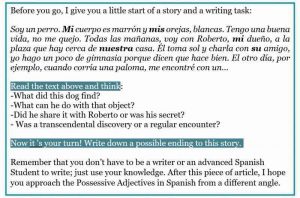Understanding Spanish text and learning to speak the Spanish language is a complex activity that involves several abilities, from recognizing the letters to using our working memory actively. Luckily, some words work as clues and help us understand the relationships between each sentence, and one of the best clues to look out for are Possessive Adjectives.
These are useful because they link two words, and allow us to understand what a sentence is referencing.
Think of Possessive Adjectives as the barcode of a product: you grab a bag of nachos, and then the supermarket system reads the barcode and knows what to charge you, because they link the product with the price. The same happens with words.
Take a look at this example of Possessive Adjectives in Spanish:
Tomás come su pizza
Thomas eat his pizza
Su is the equivalent in Spanish of the Possessive Adjective “his/her”. As you might have guessed, because life is not easy, the word classification has its tricks.
Experts often talk about the different grammar theories regarding these types of words because they are not simply qualified. Spanish linguists debate whether they are determinantes or pronombres but as we are not grammar specialists we have less of a problem.
For the time being what matters about these words is their use. So, if you check the example below, you will see that su links pizza with Tomás. This helps us to avoid spending cognitive efforts when reading a text, as we “solve” the relationship between those words easily, we can move on to the next sentence without much hesitation and, in that way, we don’t get tired or lost.
Is this privative of reading comprehension? No, we make connections when we’re writing too. Look at this new example:
Tomás viste mi campera
Thomas wears my jacket
With that sentence, I’m telling my readers something additional, because I am preparing them to encounter two people, Thomas and I.
Imagine it is the beginning of a story, that pronoun works as a warning: Watch out! This text is written from the view of a first-person narrator (I), which means that Thomas is not the only character in the story.
Luckily for us, all this reasoning happens automatically. In other words, we don’t realize the activities involved in reading or writing (thank you, brain) but it is important to discuss language so that our learning is reflective.
Let’s take a look at the different Possessive Adjectives in Spanish:
It is important to clarify that vuestra/vuestro/vuestros/vuestras is not used in every Spanish-speaking region. For instance, in Latin America. Maybe you notice that British English and American English have their differences, the same occurs between Spanish from Spain and other varieties like español rioplatense (the one spoken in Uruguay and Argentine).
Let’s take a look at some other examples:
Su perro se llama Tito
His/Her dog is called Tito
Nuestro auto es rojo
Our car is red
¡Es tu culpa!
It’s your fault!
You might have noticed that su can be her, his, or their. Could you think of a possible way to disambiguate the meaning?
Yes! Using the context – or the words – around that term can help us to clarify the meaning. That’s why it is so crucial to recognize the relationships between each sentence. Of course, that is something we do orally, too. In that case, we wait until our speaker clarifies the reference.
However, there is a tiny difference between talking or reading.
Imagine we’re talking, and I use su but it’s not clear if I am referring to “her” or “their”, you wait until I give you extra information, but I keep being ambiguous, so you can interrupt me and ask me something like “Sorry, are you talking about her or them?”, easy peasy, right?
What happens when reading a text? You can shout a question at the paper or screen, but it won’t answer it back. Using contextual information is extremely helpful in this case.
Now, I’ll leave you here this link of a song written by an famous Argentinean singer, Fito Paez:
https://www.youtube.com/watch?v=YJ54ITzorwI
In that song called “Mi vida, tu vida” (“my life, your life”) you will find examples of Possessive Adjectives in Spanish such us:
Sus ojos son un mar profundo
Her/ his eyes are a deep sea
Yo escribo aquí en mi habitación
I write here in my bedroom
Cuando nuestras pieles se conectan al brillar
When our skills connect to shine
Possessive Adjectives in Spanish can be difficult to qualify (some grammars tend to consider them determinantes, other pronombres) but they are very helpful when reading or writing a text. Thanks to those types of words, we can identify the link between two words or sentences. Also, they give certain unity to the text, making it easier to comprehend.
Micaela Canal


